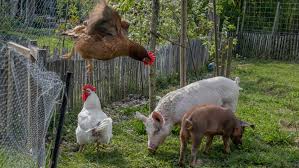In central Oregon, an outbreak of bird flu has affected a pig in addition to other chickens at a backyard farm.
Although the infection seems to be limited to a single farm, the exposure has raised new concerns because pigs serve as a natural influenza-containing material that can cause genetic mutations that could put humans at risk.
Below is current information on the case and its potential dangers.
The H5N1 strain of bird flu has first infected pigs in the United States, as reported by the US Department of Agriculture on October 30. An autopsy conducted on one of the pigs reported by STAT showed signs of the virus throughout its body. Two other pigs showed no signs of the virus, and results are still being collected.
Get science news headlines delivered right to your door.
Despite the continued spread of H5N1 in wild birds and mammals and outbreaks in U.S. dairy cows, USDA officials are more cautious about the safety of pork available on the farm because all but one of the pigs listed were not for commercial use.
Currently, there are more uncertainties than solutions about the case, such as the way the pigs were infected and whether the virus can spread between pigs on large farms, but swine influenza has a distinct risk factor that raises concerns about the impact of H5N1 on pigs and humans.
Pigs have long been known as flu “mixing vessels,” and people are at risk of contracting the virus by latching on to and breaking down cells.
With their combination of bird and human-like receptors, pigs can contract both swine-specific flu and viruses from birds and humans. This facilitates gene swapping between avian flu viruses and human viruses, which can result in an increased risk of infectious diseases.
The 1918 influenza pandemic is believed to have been caused by pigs, which are believed to be responsible for the outbreak. The 2009 swine flu outbreak also began in pigs, and may have undergone reassortment before the ongoing cattle outbreak (SN: 5/16/24).
H5N1 has been closely monitored by experts in the U.S. since 2022, who have discovered changes in the virus’s genetic makeup from animal samples.
Some of the changes that facilitate the multiplication of avian-origin viruses in human cells have been introduced in animals such as sea lions and cattle, as well as in some cases in farmers who came into contact with dairy cows. However, avian influenza can still spread efficiently between individuals by dodging parts of our immune system, as seen in the use of human sialic acid receptors instead of bird versions (although there is no conclusive evidence that this has been done).
Pigs may be able to exchange genes of H5N1 viruses, which have historically been relatively unpopular among pigs, resulting in at least some strains of H5N1 in pigs — a finding that researchers reported in the April Emerging Infectious Diseases journal.
While the possibility of a human pandemic remains a figment of imagination, the potential for an outbreak in people is a theoretical possibility, given that only wait-listed pigs have had confirmed virus infections, and H5N1 could potentially infect large farms.


